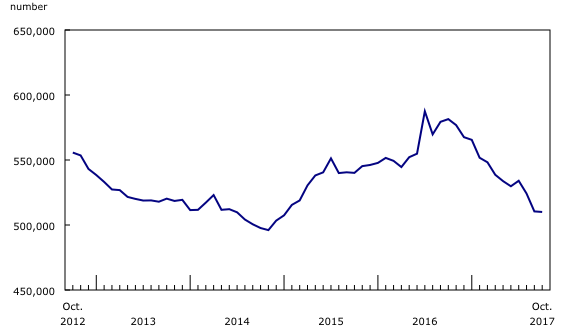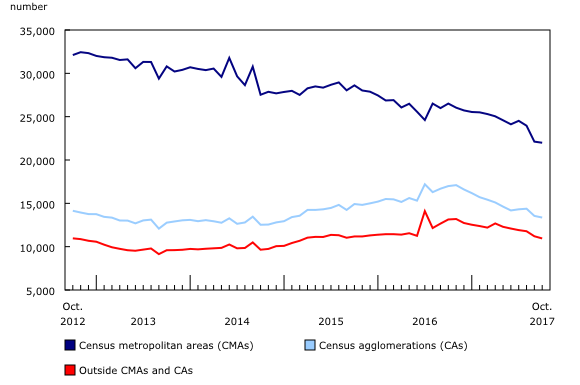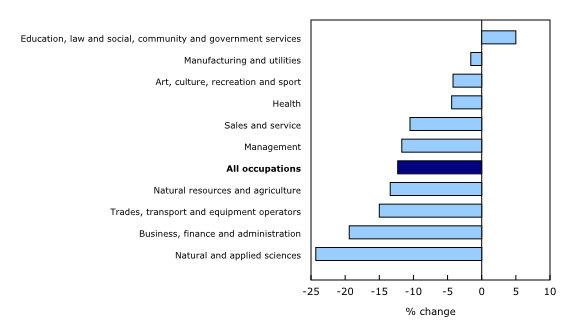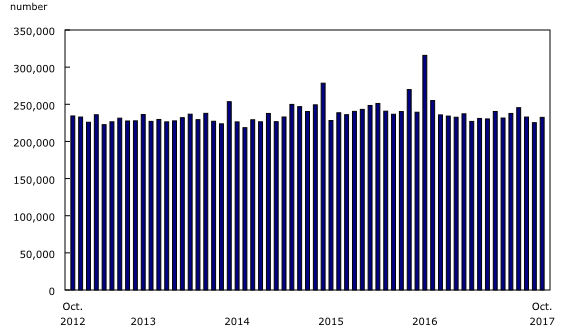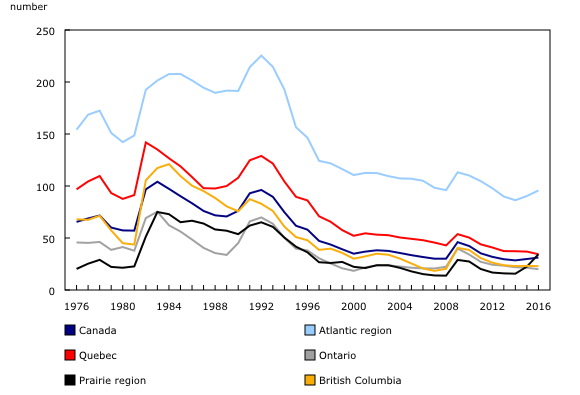Employment Insurance, October 2017
Archived Content
Information identified as archived is provided for reference, research or recordkeeping purposes. It is not subject to the Government of Canada Web Standards and has not been altered or updated since it was archived. Please "contact us" to request a format other than those available.
Released: 2017-12-19
In October, 510,000 people received regular Employment Insurance (EI) benefits, virtually unchanged from September. While there was little change for the month, the number of EI recipients has been on a downward trend since October 2016.
Provincially, there were fewer beneficiaries in Alberta (-2.3%), Quebec (-1.6%) and British Columbia (-1.2%). On the other hand, the number of people receiving benefits increased in Prince Edward Island (+3.2%) and Ontario (+2.7%), while there was little change in the remaining provinces.
In general, variations in the number of beneficiaries can reflect changes in the circumstances in a number of different groups, including those becoming beneficiaries, those going back to work, those exhausting their regular benefits, and those no longer receiving benefits for other reasons.
Compared with October 2016, the number of EI recipients in Canada declined by 12.3%, the largest year-over-year decrease since April 2012. Following the EI policy changes that came into effect in July 2016, the number of beneficiaries was unusually high in the latter half of 2016.
Provincial and sub-provincial overview
The number of beneficiaries in Alberta fell by 2.3% to 61,500 in October, continuing a downward trend that began in the latter half of 2016. Declines were spread across the province, with the census metropolitan areas (CMAs) of Calgary and Edmonton each decreasing by 2.7%. On a year-over-year basis, beneficiaries in Alberta decreased 38.1%, driven by declines among those aged 25 to 54. Over the same 12-month period, data from the Labour Force Survey (LFS) show that the unemployment rate for people aged 25 to 54 in the province also declined.
In Quebec, 125,600 people received benefits in October, down 1.6% from September. Most of the decline came from the CMAs, particularly Ottawa–Gatineau (Quebec part) (-4.2%), Québec (-2.9%), Trois-Rivières (-2.9%), Sherbrooke (-2.8%) and Montréal (-2.4%). Compared with 12 months earlier, the number of beneficiaries in the province declined 9.0%. The number of people in Quebec receiving benefits has been on a downward trend since the summer of 2016.
The number of EI recipients in British Columbia decreased 1.2% to 46,300 in October. There were declines in the CMA of Vancouver (-3.6%), the census agglomerations (CAs) (-1.4%) and areas outside the CMAs and CAs (-2.2%). On the other hand, the CMA of Abbotsford–Mission recorded an increase of 22.1%, partially offsetting a decline in the previous month. On a year-over-year basis, the number of beneficiaries in British Columbia declined 18.3%, the second fastest decrease among the provinces. The number of beneficiaries in the CMAs has been on a downward trend since the summer of 2015. Outside of the province's CMAs, the number of people receiving benefits rose throughout 2015, before trending downward beginning in autumn 2016.
In Prince Edward Island, 8,600 people received benefits, up 3.2% from September. There were increases in the CAs (+2.6%) and areas outside of the CAs (+3.6%). In the 12 months to October, the number of beneficiaries rose 9.8% in Prince Edward Island, the only province with an increase over that period. Part of the year-over-year increase may be the result of the introduction of the Training Prince Edward Island - Career Connect program. This program, which began in April 2017, allows the province's residents with an active EI claim to continue collecting benefits while enrolled in full-time postsecondary education.
Despite a decline in 11 out of 15 CMAs in Ontario, including Toronto (-4.8%), the province recorded an increase of 2.7% in the number of beneficiaries, totalling 134,500 in October. This increase was driven by the CMAs of Windsor (+177.0%) and, to a far lesser extent, London (+20.6%). These increases coincided with work stoppages and planned shutdowns in the automotive industry. Compared with October 2016, the number of beneficiaries in the province declined 4.2%.
Employment Insurance beneficiaries by occupation
In the 12 months to October, the number of beneficiaries fell in 9 of the 10 broad occupational groups. The declines were led by natural and applied sciences (-24.3%), business, finance and administration (-19.4%), trades, transport and equipment operators (-15.0%) and natural resources and agriculture (-13.4%).
The sole year-over-year increase was for beneficiaries whose last job was in education, law and social, community and government services occupations (+5.0%).
Employment Insurance beneficiaries in major demographic groups
In October, the number of women receiving benefits declined, while the number of men receiving benefits was little changed. The decrease in beneficiaries was driven by women in the core working ages of 25 to 54 (-1.5%), while the number increased 1.4% for young women aged 15 to 24.
On a year-over-year basis, beneficiaries declined in all major demographic groups, led by core-aged men (-15.6%), who made up slightly more than half the overall decline during the period.
Employment Insurance claims
The number of EI claims totalled 232,400 in October, up 3.2% from September. The number of claims provides an indication of the number of people who could become beneficiaries.
Claims increased in six provinces, led by Ontario (+5.8%) and Alberta (+5.4%). There were smaller increases in British Columbia (+2.7%), Manitoba (+2.5%), Quebec (+2.4%) and Nova Scotia (+2.2%). In turn, there were decreases in claims in Prince Edward Island (-3.2%), Newfoundland and Labrador (-3.0%), Saskatchewan (-2.4%) and New Brunswick (-2.3%).

In celebration of the country's 150th birthday, Statistics Canada is presenting snapshots from our rich statistical history.
Employment Insurance beneficiaries and the number of employed
The Employment Insurance (EI) program provides temporary support to unemployed workers seeking new employment (regular benefits) and to workers who take time off work due to specific life events (special benefits).
Statistics Canada produces and disseminates statistics on the EI program, including series on the number of beneficiaries. Over time, the number of beneficiaries is affected by labour market conditions, as well as policy changes in the EI program.
From 1976 to 2016, the number of regular EI beneficiaries decreased by 11.7%. According to the Labour Force Survey (LFS), the number of people employed nearly doubled during the same period.
In the late 1970s, there were 60 to 70 people receiving regular EI benefits for every 1,000 employed. This ratio varied with economic cycles, reaching a high of 104.1 in 1983. Since the turn of the millennium, there have generally been fewer than 40 people receiving regular benefits for every 1,000 employed. As of 2016, the ratio was 31.2.
Over the years, the number of regular beneficiaries per 1,000 employed has trended downwards for all regions and the discrepancies between regions have narrowed. The ratio for the Atlantic region decreased from 154.1 in 1976 to 95.7 in 2016, although it remained the highest among the country's regions. This coincides with a higher unemployment rate and larger proportion of employed working seasonal jobs in the Atlantic region. Also showing decreases were Quebec (from 96.8 to 34.4), British Columbia (from 68.0 to 22.9) and Ontario (from 45.7 to 20.0). Despite a general decline over the period, the ratio for the Prairie region increased to 34.4 in 2016, following the decrease in oil prices in 2014.
Due to differences in methodology, LFS data for the territories are not directly comparable to data for the provinces. Data for all territories began in 2004, when there were 68.2 regular beneficiaries per 1,000 employed. Since then, the ratio has trended downwards, reaching 53.5 in 2016.
From 1976 to 2016, the number of people receiving special benefits rose much faster than the number of people employed. Currently, special benefits mainly include sickness, maternity, and parental benefits.
Over the last 40 years, the number of sickness beneficiaries has nearly tripled in Canada, from a ratio of 2.8 sickness beneficiaries per 1,000 employed in 1976 to 4.0 per 1,000 employed in 2016. The number of people receiving maternity and parental benefits also grew faster than employment. In particular, the expansion of the parental program in 2001 boosted the ratio, which rose from 4.1 for Canada (except Quebec) to 8.3 in 2016. In Quebec, which has had its own program since 2006, the ratio increased from 2.5 in 1991 to 8.2 in 2005.
Note to readers
Concepts and methodology
The analysis presented here focuses on people who received regular Employment Insurance (EI) benefits related to job loss. Claims data pertain to initial and renewal claims received for any type of EI benefits, including special benefits.
EI statistics are produced from administrative data sources provided by Service Canada and Employment and Social Development Canada. These statistics may, from time to time, be affected by changes to the Employment Insurance Act or administrative procedures. The most recent series of changes were introduced in July 2016.
Regular EI benefits are available to eligible individuals who lose their jobs and who are available for and able to work, but cannot find a job. To receive EI benefits, individuals must first submit a claim.
EI statistics indicate the number of people who received EI benefits, and should not be confused with Labour Force Survey (LFS) data, which provide estimates of the total number of unemployed people. There is always a certain proportion of unemployed people who do not qualify for benefits. Some unemployed people have not contributed to the program because they have not worked in the past 12 months or their employment is not insured. Other unemployed people have contributed to the program but do not meet the eligibility criteria, such as workers who left their job voluntarily or those who did not accumulate enough hours of work to receive benefits.
All data in this release are seasonally adjusted. For more information on seasonal adjustment, see Seasonally adjusted data – Frequently asked questions.
Numbers in the Daily text are rounded to the nearest hundred.
The number of regular EI beneficiaries and the number of claims received for the current and previous month are subject to revision.
The number of beneficiaries is a measure of all people who received EI benefits from October 8 to 14. This period coincides with the reference week of the LFS. However, claims data are for the entire month.
Geographical definitions
A census metropolitan area (CMA) or a census agglomeration (CA) is formed by one or more adjacent municipalities centred on a population centre. A CMA must have a total population of at least 100,000. A CA must have a population of at least 10,000. See Standard Geographical Classification 2011 – definitions for more information.
Next release
Data on Employment Insurance for November 2017 will be released on January 18, 2018.
Products
More information about the concepts and use of Employment Insurance statistics is available online in the Guide to Employment Insurance Statistics (73-506-G).
Contact information
For more information, contact us (toll-free: 1-800-263-1136; 514-283-8300; STATCAN.infostats-infostats.STATCAN@canada.ca).
To enquire about the concepts, methods or data quality of this release, contact Marton Lovei (613-240-3623; marton.lovei@canada.ca) or Client Services (toll free: 1-866-873-8788; statcan.labour-travail.statcan@canada.ca), Labour Statistics Division.
- Date modified:




